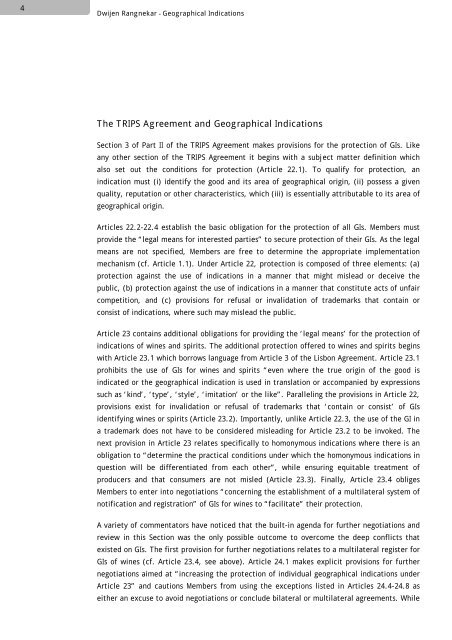Geographical Indications
Geographical Indications
Geographical Indications
You also want an ePaper? Increase the reach of your titles
YUMPU automatically turns print PDFs into web optimized ePapers that Google loves.
4Dwijen Rangnekar - <strong>Geographical</strong> <strong>Indications</strong>The TRIPS Agreement and <strong>Geographical</strong> <strong>Indications</strong>Section 3 of Part II of the TRIPS Agreement makes provisions for the protection of GIs. Likeany other section of the TRIPS Agreement it begins with a subject matter definition whichalso set out the conditions for protection (Article 22.1). To qualify for protection, anindication must (i) identify the good and its area of geographical origin, (ii) possess a givenquality, reputation or other characteristics, which (iii) is essentially attributable to its area ofgeographical origin.Articles 22.2-22.4 establish the basic obligation for the protection of all GIs. Members mustprovide the “legal means for interested parties” to secure protection of their GIs. As the legalmeans are not specified, Members are free to determine the appropriate implementationmechanism (cf. Article 1.1). Under Article 22, protection is composed of three elements: (a)protection against the use of indications in a manner that might mislead or deceive thepublic, (b) protection against the use of indications in a manner that constitute acts of unfaircompetition, and (c) provisions for refusal or invalidation of trademarks that contain orconsist of indications, where such may mislead the public.Article 23 contains additional obligations for providing the ‘legal means’ for the protection ofindications of wines and spirits. The additional protection offered to wines and spirits beginswith Article 23.1 which borrows language from Article 3 of the Lisbon Agreement. Article 23.1prohibits the use of GIs for wines and spirits “even where the true origin of the good isindicated or the geographical indication is used in translation or accompanied by expressionssuch as ‘kind’, ‘type’, ‘style’, ‘imitation’ or the like”. Paralleling the provisions in Article 22,provisions exist for invalidation or refusal of trademarks that ‘contain or consist’ of GIsidentifying wines or spirits (Article 23.2). Importantly, unlike Article 22.3, the use of the GI ina trademark does not have to be considered misleading for Article 23.2 to be invoked. Thenext provision in Article 23 relates specifically to homonymous indications where there is anobligation to “determine the practical conditions under which the homonymous indications inquestion will be differentiated from each other”, while ensuring equitable treatment ofproducers and that consumers are not misled (Article 23.3). Finally, Article 23.4 obligesMembers to enter into negotiations “concerning the establishment of a multilateral system ofnotification and registration” of GIs for wines to “facilitate” their protection.A variety of commentators have noticed that the built-in agenda for further negotiations andreview in this Section was the only possible outcome to overcome the deep conflicts thatexisted on GIs. The first provision for further negotiations relates to a multilateral register forGIs of wines (cf. Article 23.4, see above). Article 24.1 makes explicit provisions for furthernegotiations aimed at “increasing the protection of individual geographical indications underArticle 23” and cautions Members from using the exceptions listed in Articles 24.4-24.8 aseither an excuse to avoid negotiations or conclude bilateral or multilateral agreements. While









